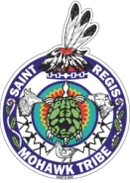Unique St. Lawrence River Restoration Joint Coordination Will Benefit Region’s Ecosystem and Cultures
The New York State Department of Environmental Conservation (DEC) and the Saint Regis Mohawk Tribe (SRMT) today announced the signing of a historic cooperative agreement that will help accelerate restoration of natural resources and traditional Native American uses within the St. Lawrence River Area of Concern (AOC) near Massena, New York, and the Akwesasne Territory. This cooperative agreement is the first of its kind across the United States portion of the Great Lakes and provides a new roadmap for coordinating studies and restoring natural and cultural resource uses between the two government agencies, while recognizing their unique jurisdictions and shared interests.
“The formalization of this agreement is the culmination of a new, exciting, and historic partnership between the Saint Regis Mohawk Tribal Council and New York State,” said DEC Commissioner Basil Seggos. “Representatives from each worked diligently over the past several months to finalize this formal agreement and I look forward to working together to restore the St. Lawrence region’s habitat and wildlife for the benefit of current and future generations.”
“When the Area of Concern was first identified in 1987, the Saint Regis Mohawk Tribe voiced the need to have Akwesasne recognized as an equal partner in remediating the serious environmental pollution inflicted upon our territory,” the Saint Regis Mohawk Tribal Council said. Tribal Council added, “Through the coordination of our environmental programs, which included the diligent efforts of SRMT St. Lawrence River AOC Program Manager Jessica Jock, our special position and environmental expertise is now acknowledged in the first state-tribal partnership throughout the Great Lakes Basin under the Great Lakes Water Quality Agreement.”
Areas of Concern are geographic areas around the Great Lakes that are environmentally degraded. In 1987, the Great Lakes Water Quality Agreement designated 43 AOCs in order to focus restoration work on these areas. The Massena area of the St. Lawrence River was originally listed as an AOC because of elevated levels of heavy metals and PCBs in sediments, wildlife, and water samples collected in the lower Grasse, Raquette, and St. Regis rivers. Significant progress is being made in remediating and restoring these waters, but more work remains.
To set the stage for this agreement between DEC and the Saint Regis Mohawk Tribe, extensive consultations were held that culminated in the U.S. Environmental Protection Agency’s (EPA) recognition of three administrative changes to the AOC’s Remedial Action Plan. Key features of the cooperative agreement include: (1) having representatives of both DEC and the SRMT serve as co-coordinators for implementation of the AOC’s Remedial Action Plan; (2) developing resource restoration plans to include both natural and cultural resources within the AOC; and (3) enhanced outreach and education of surrounding communities to improve the understanding and support of the agencies efforts.
One immediate outcome of the state-tribal partnership will be the revitalization of the Remedial Advisory Committee to consist of members of the local Massena community and tribal representatives who will each embrace their collective role and responsibilities in helping the governments move toward ultimately delisting the St. Lawrence River as an Area of Concern.
The agreement also includes the formal renaming of this unique location from the “St. Lawrence River at Massena” to the “St. Lawrence River Area of Concern at Massena/Akwesasne” to better represent the AOC’s geographic scope and the longstanding efforts of the Mohawk governments at Akwesasne to protect and enhance the water quality of territorial waterways. A new map has been developed that captures the extent of the Akwesasne Territory and identifies traditional use areas within the AOC. The map also identifies areas of the Akwesasne community that are overseen by respective Mohawk governments, which will now be used to better inform and coordinate efforts associated with the AOC’s Remedial Action Plan amongst various environmental agencies and stakeholders.
###

